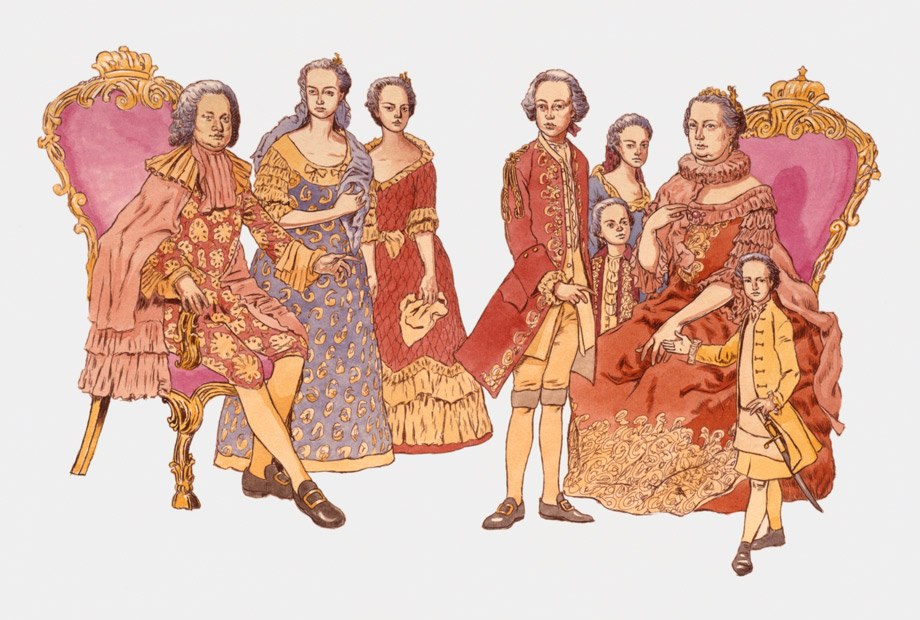This post originally appeared on Riley’s blog, uneasy-lies-the-crown.com, which features her writing and podcasts about the intersection of neuroscience and royalty.
Our tale begins in my ninth grade history classroom. One day, we were learning about the Habsburgs (also spelled Hapsburg), a German-Austrian royal family that included Marie Antoinette and Marie de Medici and ruled great swaths of Europe between 1100 and 1700. My teacher pulled up a horrifying drawing of a person who looked more animal than human. This, he said, was what the Habsburg offspring looked like toward the end of the family’s reign due to a little thing called inbreeding. The picture may have been a cartoonish overdramatization, but the science behind it was real.
Marriages between relatives have been common in royal families throughout history, but the Habsburgs took inbreeding to a whole new level. Never before had relatives so close to one another married with such frequency. Strategic marriage formed the basis of their foreign policy, in accordance with their family motto: “Let others wage war, but you, happy Austria, marry.” While intrafamilial marriages strengthened their empire for a time, they eventually led to its demise.
Not only is inbreeding morally repugnant, but it’s also genetically disadvantageous. Think of purebred dogs, inbred to maintain purity, that end up with a multitude of genetic defects. The same thing happened to the Habsburgs. At conception, you inherit a set of genes from each parent in the form of a set of chromosomes. These chromosomes are able to swap pieces of genes with one another in order to increase genetic diversity. Aside from making you unique, this serves the important evolutionary advantage of minimizing the effect of any deleterious genes you may have inherited. For example, if your dad gave you a defective version of a gene (cough, my lactase enzyme), your mom’s copy can pick up the slack. But when closely related individuals have children, there is more of a chance that both parents have the same genetic defect. As a result, inbreeding increases the risk of rare genetic mutations.
There’s actually a mathematical way to measure this effect, called the inbreeding coefficient. This coefficient, with possible values ranging from 0 to 1, represents the probability that two copies of a gene inherited from each parent are identical due to a common ancestor. A study published by researchers from the University of Santiago de Compostela in Spain in 2009 found that the inbreeding coefficient for the last Habsburg ruler, King Charles II of Spain, was 0.254, higher than it would be if he was the result of a mating between parent and child.
Although the Habsburgs benefited politically from their strategic marriages, they suffered biologically. Royal portraits regularly show members of the family with a pronounced chin dubbed the “Habsburg jaw.” Another group of researchers from Spain were able to find a correlation between a family member’s inbreeding coefficient and the degree of their jaw deformity, thought to be a genetic trait called mandibular prognathism, based on paintings and historical records. Inbreeding also increased the risk of child mortality for Habsburg offspring, with the probability of a child surviving to 10 years old decreasing to less than 50% as the inbreeding coefficient reached 0.254.
Ultimately, the effect of inbreeding on fertility brought down the Habsburgs’ centuries-long rule over Europe. The subtle facial features that were seen throughout the family dynasty became debilitating deformities for Charles II, the last Habsburg king. He was severely mentally and physically disabled, barely able to walk or talk until he was 10, and had lifelong difficulty speaking and eating due to his jaw deformity. He was known as “El Hechizado” or “The Hexed” due to his impairments, which were likely caused by the inbred genes he inherited. Although he was married twice, he had no children, and his first wife made sure to tell everyone about his infertility (another symptom that could be explained by his highly inbred genetic profile). Thus, when Charles II died in 1700, the family empire died with him. You can conquer land, you can win wars, you can dominate trade. But at the end of the day, you can’t fight nature.
References
ABRI, U. (n.d.). Retrieved from http://abri.une.edu.au/online/pages/inbreeding_coefficient_help.htm
Alvarez, G., Ceballos, F. C., & Quinteiro, C. (2009). “The Role of Inbreeding in the Extinction of a European Royal Dynasty.” PLoS ONE,4(4). doi:10.1371/journal.pone.0005174
Royde-Smith, J. G. (2019, October 16). “House of Habsburg.” Retrieved from https://www.britannica.com/topic/House-of-Habsburg/
Thulin, L. (2019, December 04). “The Distinctive 'Habsburg Jaw' Was Likely the Result of the Royal Family's Inbreeding.” Retrieved from https://www.smithsonianmag.com/smart-news/distinctive-habsburg-jaw-was-likely-result-royal-familys-inbreeding-180973688/
“How Inbreeding Doomed the House of Habsburg” (2020, April 08). Retrieved from https://blog.23andme.com/ancestry-reports/inbreeding-doomed-habsburg/
Vilas, R., Ceballos, F. C., Al-Soufi, L., González-García, R., Moreno, C., Moreno, M., . . . Álvarez, G. (2019). “Is the ‘Habsburg jaw’ related to inbreeding?” Annals of Human Biology, 46 (7-8), 553-561. doi:10.1080/03014460.2019.1687752
Related Content
- Words and Their Stories: The History and Future of Two Spirit Communities
- Reflections from International Scholarly Concentration Research
- Summer Reading from the Hopkins History of Medicine Department
Want to read more from the Johns Hopkins School of Medicine? Subscribe to the Biomedical Odyssey blog and receive new posts directly in your inbox.
